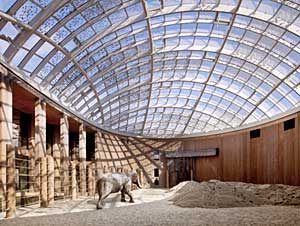An elephant house designed by Foster + Partners for the Copenhagen Zoo, in Denmark, opened this week, marking the firm’s first zoological building. “I don’t know how I can go back to designing office blocks for grumpy humans after this,” John Jennings, a lead architect on the project, told The Guardian newspaper. According to Foster’s office, the design was guided by research on the behavioral patterns of elephants. Because bull elephants tend to wander away from their herd, the designers created two sunken enclosures, both made of terra-cotta colored concrete and topped by glass domes. The fritted glass is meant to simulate a tree canopy, and operable windows provide natural ventilation. A viewing platform wraps around the outside of the glazed domes, allowing visitors to peer down into the paddocks, which feature mud holes, a pool, and objects that provide shade for the elephants. A ramp between the enclosures leads to an educational exhibition space below the viewing terrace. The project’s design group leader, Armstrong Yakubu, told The Independent newspaper that creating an optimal habitat for the animals was their primary concern. “It’s about light, sand, and air for the elephants,” he says, “and we had to find a way for humans to slip through their spaces.” Members of Denmark’s royal family attended the opening ceremony on Tuesday, June 10.

Students and alumni of the Art Center College of Design in Pasadena, California, are urging school trustees to abort their plans to construct a $50 million building design by Frank Gehry. The project opponents think the private institution—a leading graphic and industrial design school—is “putting too much money and energy into expanding its campus and promoting itself to outsiders”; they would rather the money be put toward instruction and tuition assistance, according to a June 11 article in the Los Angeles Times. Gehry’s building would contain a library and studio space and would sit on the main campus, near a bridge-like structure designed by the late Modernist architect Craig Ellwood and completed in 1976. A petition posted online casts the school’s president, Richard Koshalek, former director of L.A.’s Museum of Contemporary Art, as “an empire builder” and urges trustees to “take immediate action to again make education the school’s top investment.” Project supporters launched a counter-petition on June 6.
Should a building commissioner be a licensed architect or engineer? New York City officials are considering dropping the requirement as they continue to search for a replacement for Patricia Lancaster, FAIA, who resigned in April amid a streak of fatal construction accidents. According to a June 11 article in The New York Times, Mayor Michael Bloomberg and City Council speaker Christine C. Quinn want “to deepen the pool and managerial talent of candidates for the job.” The proposition has drawn sharp criticism from architecture and engineering groups. If the requirement is revoked, Robert Stelianou, president of the New York State Society of Professional Engineers, says his group will sue. Rick Bell, executive director of the AIA New York chapter, said in an e-Oculus article, “Like the health department, it is necessary to employ a certified professional when life and death [are] involved.”

Post a comment to this article
Report Abusive Comment